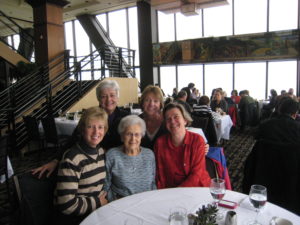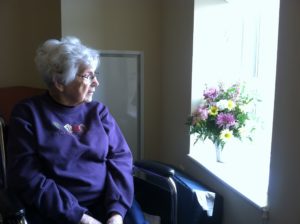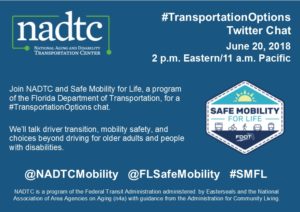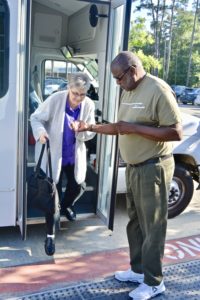Last year Easterseals published a guest post I wrote called How One Student Who is Blind Planned the Perfect Date. Our perfect date didn’t work out that time, unfortunately.

Alicia and Joe.
Joe and I had tried to plan a trip to Andy’s Jazz Club in Chicago last year for our second anniversary, but when it didn’t work out, we tried again for this year. We have been planning this since December, so needless to say, I’d been looking forward to this for a very long time.
The day finally arrived. I was up early and scheduled our ride from campus to the Elburn train station, and I called Flash Cab Chicago to schedule two rides with them — from the train station to Andy’s, and from Andy’s back to the train station later that night. I informed them that we are both blind, so the driver would have to come get us. The dispatcher added this to her notes, and I could tell from her tone that this was nothing new to them.
The trip from Northern Illinois University to Elburn was nothing new to me. We got to the station just as the train was arriving; I could hear the loud train bells. The driver led us to the platform and onto the train, directed us to our seat, and told us to have a good day as she descended the stairs off the train. And as typical with traveling with Joe, the excited chatter started.
The hour-and-twenty minute train ride didn’t feel quite that long. We pulled in right on schedule, and my excitement quickly turned to nervousness. Here was something unfamiliar to me that I was not exactly confident about: getting off the train and out of the station. I was glad I’d scheduled our pick-up time with Flash Cab for 30 minutes after our train was due in Chicago. I overestimated the time it might take on purpose, just in case the train was late. Or in case it took us a while to get out of the station…or in case I needed to make a stop. Which I did.
I wasn’t sure who to ask. What if someone led us to the restroom and left and we couldn’t find someone to lead us back? I started voicing my worries out loud and, as per usual, Joe calmly said his favorite thing to say when traveling: “We’ll figure it out,” with a reassuring hold onto my hand.
The conductor guided us off the train and asked what we needed. “Well, our cab isn’t coming for a while, so I was wondering if you had an employee that could direct us to a restroom,” I said. I didn’t want to assume he would do it when he likely had other things to attend to, but he said he’d grab his bag and take us.
During the long walk to the restrooms, our conversation was all about what we were doing in the city today, how often we travel on the train, and how impressed he was by our confidence with this being our first trip to the city by ourselves. Once he’d led us to the restrooms, he told us he had another train to get to and informed us that a security guard would be there to lead us the rest of the way. He introduced himself and shook both our hands and departed.
As promised, the security guard was there when I exited. He led us to the exit on Madison Street, where I then received a text that our cab was on its way. There was more excited chatter (I said something like, “Can you believe it? We’re in Chicago!” like I’d never been to the city before in my life and was an out-of-state tourist.)
I received another text saying the cab arrived, but decided to stay put. I always let drivers come to me; I never try and find them. The driver addressed me by name, so I knew it was the right person.
The ride to the jazz club was short, and we arrived just as the dining area opened. Someone was there to greet us, and I gave them my last name for the reservation I had made two weeks ago. He led us to our table, and I immediately took note of the instruments I could hear to our right…very closely to our right. We were sitting right by the band!
Our server came by and asked if we needed help with the menus. Joe and I had done some research prior to this trip and looked up the menu online, but we quickly found out it had been updated since then. We narrowed down our options to pasta, and the server was happy to help.
He read everything and described it to us. He politely asked me to confirm where I got the menu online so they could update it, and I told him. We got our food right as the band began to play, so there wasn’t much conversation. It was too loud, and I was too busy enjoying the music anyway.
We spent two hours in the dining area (including eating dessert, of course), before we asked our server to lead us to the bar, where we quickly struck up conversation with a lady sitting next to me. She was visiting Andy’s Jazz Club for the first time, too.
The bar area was a little better. It was quieter so we could actually talk without having to shout. As soon as I got the text that our cab was on the way, we stood up and someone came over to help us. (People were watching out for us all evening.) They led us out the door just as the cab pulled up.
The cab driver led us into the station and found a security guard, who proceeded to use his radio to request assistance. Someone came and led us to the ticket agent, and once we had our tickets, the employee who led us to the agent then led us on the train.
Unlike the train ride to Chicago, the train ride back from Chicago was quiet. We were both exhausted, so we dozed off, but in-between sleep sessions we had a little bit of conversation. I couldn’t have asked for a better person to travel with and share the last three years of my life with. We talked about doing this as a yearly tradition — that’s how much fun we had.
Our train pulled up right on time, and my cousin met us at the platform to drive us back to campus. I can’t describe the feeling of accomplishment I felt at the end of it. I stepped out of my comfort zone and tried something new, and I knew I’d go back and do it again.
More posts by Ali:
- 9 Tips for Keeping the Romance Alive in a Relationship
- 7 Advantages of Being Blind
- “Dating someone who is blind is honestly not as hard as it sounds”
 With all the hubbub the past couple weeks about our Illinois Senator Tammy Duckworth (pictured right) casting a vote on the Senate floor with her newborn baby in her arms, very little attention was given to the fact that Senator Duckworth is a mother who has a disability.
With all the hubbub the past couple weeks about our Illinois Senator Tammy Duckworth (pictured right) casting a vote on the Senate floor with her newborn baby in her arms, very little attention was given to the fact that Senator Duckworth is a mother who has a disability.




 Before I had an iPhone, I had a Samsung Jack. It’s been six years since I had that old phone, but I can vaguely remember the layout — it looked like a Blackberry. The speech software for the Samsung Jack was called Mobile Speak, and it didn’t come with the device. We had to download it separately.
Before I had an iPhone, I had a Samsung Jack. It’s been six years since I had that old phone, but I can vaguely remember the layout — it looked like a Blackberry. The speech software for the Samsung Jack was called Mobile Speak, and it didn’t come with the device. We had to download it separately.

 Just got back from a trip to Washington, DC. While walking around with friends there, I couldn’t help but notice how nice the streets and sidewalks in DC and nearby Alexandria are — guess I’ve become too accustomed to the cracks and potholes and construction cut-outs here in Chicago!
Just got back from a trip to Washington, DC. While walking around with friends there, I couldn’t help but notice how nice the streets and sidewalks in DC and nearby Alexandria are — guess I’ve become too accustomed to the cracks and potholes and construction cut-outs here in Chicago! A small dog yipped and lunged at my Seeing Eye dog Whitney as we checked in for a flight at Chicago’s Midway Airport last month. No one got hurt, but it was alarming.
A small dog yipped and lunged at my Seeing Eye dog Whitney as we checked in for a flight at Chicago’s Midway Airport last month. No one got hurt, but it was alarming.

 When my mother died a few years ago, she left a small amount of money to each of her grandchildren. Except for our son Gus. We specifically asked her not to include him in her will.
When my mother died a few years ago, she left a small amount of money to each of her grandchildren. Except for our son Gus. We specifically asked her not to include him in her will. Is it just me, or have you noticed a trend in “adaptive fashion” lately? It seems more and more stylish apparel is being designed for a variety of audiences:
Is it just me, or have you noticed a trend in “adaptive fashion” lately? It seems more and more stylish apparel is being designed for a variety of audiences:







 Magnets and Ladders publishes writing by people with disabilities, and they’ll be holding contests in the areas of fiction, nonfiction, and poetry for the Fall/Winter 2018 issue. Cash prizes of $30 and $20 will be awarded to the first and second place winners in each category. Their
Magnets and Ladders publishes writing by people with disabilities, and they’ll be holding contests in the areas of fiction, nonfiction, and poetry for the Fall/Winter 2018 issue. Cash prizes of $30 and $20 will be awarded to the first and second place winners in each category. Their  Independence Day has come and gone, but there’s still a lot to celebrate this month: It’s the anniversary of the ADA and many cities across the country are celebrating disability pride! One way to celebrate and learn about the contributions of people with disabilities is by reading books about them. Earlier this month I put together a blog
Independence Day has come and gone, but there’s still a lot to celebrate this month: It’s the anniversary of the ADA and many cities across the country are celebrating disability pride! One way to celebrate and learn about the contributions of people with disabilities is by reading books about them. Earlier this month I put together a blog  I’ve published posts here about the obstacles people with disabilities often run into at polling places, and after an op-ed piece I wrote about this
I’ve published posts here about the obstacles people with disabilities often run into at polling places, and after an op-ed piece I wrote about this  With cyber concerns in the news these days, many polling places are considering returning to paper ballots in future elections. I get that, but here’s the thing: many people with disabilities cannot mark paper ballots without assistance.
With cyber concerns in the news these days, many polling places are considering returning to paper ballots in future elections. I get that, but here’s the thing: many people with disabilities cannot mark paper ballots without assistance. The 28th anniversary of the signing of the Americans with Disabilities Act (ADA) is this Thursday, July 26. My husband Mike and I will be celebrating with a visit to see our son at his group home in Wisconsin. Gus moved away from home when he was 16 years old — he was born with significant physical and developmental disabilities. He can propel his own wheelchair, but when we take him for walks from his group home to the park, his dad supplies the horsepower. I hold Mike’s arm as he pushes Gus’ wheelchair up the ramps to the sidewalks, and once we’re in the park we head to the swing — it’s especially suited for wheelchair use. Our visits are happy and uneventful, and on the drive back to our hotel room, we often talk about how grateful we are that the Americans with Disabilities Act (ADA) was signed into law when it was, back in 1990.
The 28th anniversary of the signing of the Americans with Disabilities Act (ADA) is this Thursday, July 26. My husband Mike and I will be celebrating with a visit to see our son at his group home in Wisconsin. Gus moved away from home when he was 16 years old — he was born with significant physical and developmental disabilities. He can propel his own wheelchair, but when we take him for walks from his group home to the park, his dad supplies the horsepower. I hold Mike’s arm as he pushes Gus’ wheelchair up the ramps to the sidewalks, and once we’re in the park we head to the swing — it’s especially suited for wheelchair use. Our visits are happy and uneventful, and on the drive back to our hotel room, we often talk about how grateful we are that the Americans with Disabilities Act (ADA) was signed into law when it was, back in 1990. Earlier I walked you through
Earlier I walked you through  My Seeing Eye dog and I are heading to California this afternoon — I was awarded a grant to attend the
My Seeing Eye dog and I are heading to California this afternoon — I was awarded a grant to attend the 







